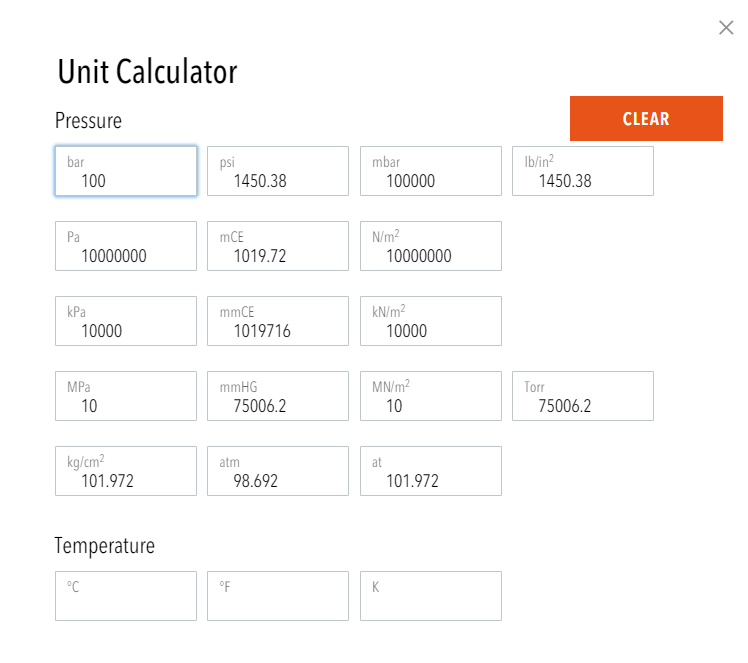Pressure measurement units and their conversion
The most widely used unit for expressing pressure worldwide is "bar". This can be explained, among other things, by the fact that most of the pressures we encounter in everyday life can be expressed in simple numbers in bar: Atmospheric pressure approx. 1bar, air pressure in the tyres of bicycles and cars from approx. 2bar to just under 10bar (for racing bicycles), the pressure at a depth of 10m in water is approx. 1bar.
In industrial applications, too, the indication in bar is frequently encountered, for example the pressure in pneumatic systems is often about 6 bar, while in hydraulic systems between 250 and 600bar are measured. However, bar is not an SI unit. SI stands for Système international d'unités, a system of units for physical quantities that is used worldwide and whose units are prescribed in business and official transactions in many countries.
The SI unit for pressure is Pascal (Pa). One pascal corresponds to the product of the SI base units kg * m * s⁻² or, in derived SI units, N/m². The advantage of pascal is that you do not have to convert this pressure unit when it is used in physical formulae, as these are normally built on the SI base units. The disadvantage of Pascal is that the unit corresponds to a very small pressure, which is not commonly used in everyday life. For example, one bar corresponds to 100,000Pa. Therefore, "Pa" very often has to be prefixed with hecto (hundred), kilo (thousand) or mega (one million) in order to indicate the pressure value with numbers that are reasonably easy to read. The prefix milli is also commonly used with bar for small pressure values: pressures below 1bar are often indicated in mbar (millibar).


In the Anglo-Saxon world, namely in the USA, the units around pounds and inches are common. Therefore, the pressure unit commonly used there is "psi", which corresponds to pound-force-per-square-inch. Converted, 1psi corresponds to approx. 6895Pa or 0.07bar, or 1bar corresponds to approx. 14.5psi. To distinguish between absolute and relative pressure, the unit of pressure psi is often replaced by the letters "a" to psia for absolute pressure or "g" (for gauge) to psig. (for gauge) to psig for relative pressure.
There are also pressure units derived from certain measuring media, for example the millimetre water column, expressed as mmWS in German or mmCE (mm colonne d'eau) or mmWC (mm water column). This unit is mainly used in applications related to water pressure measurement for pumps, level, etc. The pressure unit millimetre of mercury column (mmHg), often expressed in "Torr", is based on a mercury barometer defined by Evangelista Torricelli. It is still partly used in the medical environment.
Based on the atmospheric pressure, there are other pressure units besides the "Torr" or "mmHg" just mentioned, such as "atm", where 1atm corresponds to a standard atmosphere of 101,325Pa. The unit "at", the technical atmosphere, was set at 1 at = 10mWS. However, it is also not an SI unit and is rarely used today.
Conversions
1 Pa = 1 kg * m * s⁻²= 1 N / m²
1 MPa = 1'000'000 Pa = 10⁶ Pa
1 kPa = 1’000 Pa
1 hPa = 100 Pa
1 bar = 10⁵ Pa
1 psi = 6’894.74 Pa
1 atm = 101’325.33 Pa
1 mmCE = 9.80665 Pa
1 mm HG = 1 Torr = 133.322312 Pa
Temperature units and their conversion
The only temperature units used in technology and in everyday life are degrees Celsius "°C", Kelvin "K" (called without degrees) as the SI unit, and degrees Fahrenheit "°F". The Celsius scale was defined as the range between the melting and boiling points of water, divided into one hundred units. The Kelvin scale uses the same increment, but starts at absolute zero, which is - 273.15°C. The unit Fahrenheit is mainly used in the USA and has a finer division as well as a different zero point than Celsius and Kelvin. Thus, 0°C corresponds to the value of 32°F.
Conversions
T [°C] = T [K] - 273.15
T[°C] = (T[°F] – 32) * 5/9
How do I get to the unit calculator of Trafag?
To facilitate the conversion of the numerous pressure units used in technology and in everyday life, Trafag provides the Unit Converter on its website. Click on "Unit Calculator" in the top right navigation (see picture below) and the calculator will appear automatically. Please enter the value and wait until the conversion has taken place.


Do you have questions or inputs about the pressure converter? Please contact us. We are looking forward to hearing from you!
